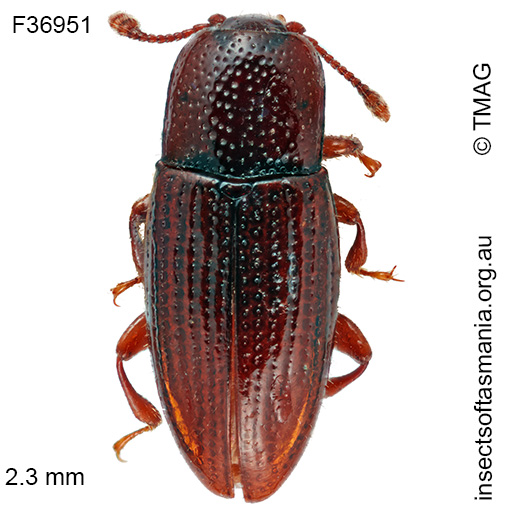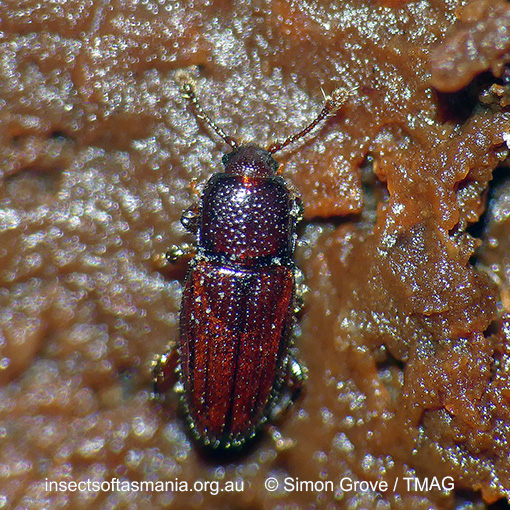
Philothermus tasmanicus Ślipiński
Basis for Tasmanian occurrence
TMAG collections
Classification
Order: Coleoptera
Suborder: Polyphaga
Superfamily: Coccinelloidea
Family: Cerylonidae
Morphology
Flightedness: winged and assumed capable of flight
Source literature on morphology and taxonomy (*primary taxonomic source, where identified):
*Ślipiński, S.A. (1988). Revision of the Australian Cerylonidae (Coleoptera: Cucujoidea). Ann. Zool. Polsk. Akad. Nauk, Inst. Zool. 30 (V): 1-72.
Ecology
Association with dead wood or old trees: at least facultatively saproxylic
Ecological attributes: — Associated with discoloured wood (Harrison, 2007) — Associated with mudguts (Yee et al., 2006) — Associated with red-brown blocky muddy rock (Yee et al., 2001) — Associated with small pocket rot (Harrison, 2007) — May occupy logs or trunks of Eucalyptus obliqua, at least temporarily, since found having emerged within six years of felling (Grove et al., 2009).
Collection method(s) for TMAG material: — Baited trapping (funnel trap) — Emergence trapping from cut billets of Eucalyptus obliqua (Harrison, 2007) — Emergence trapping from log of Eucalyptus obliqua — Hand collection (substrate not specified) — Knockdown fogging of canopy of Nothofagus cunninghamii — Pitfall trapping — Trapping using a range of devices placed in crown of Eucalyptus obliqua (Bar-Ness, 2005).
Source ecological literature:
Grove, S.J. (2009b). Beetles and fuelwood harvesting: a retrospective study from Tasmania’s southern forests. Tasforests 18: 77-99.
Hopkins, A.J.M. et al. (2005). Wood decay fungi and beetle assemblages associated with living Eucalyptus obliqua trees: early results from studies at the Warra LTER Site, Ta
Yee, M. et al. (2001). Not just waste wood: decaying logs as key habitats …: the ecology of large and small logs compared. Tasforests 13: 119-128.
Baker, S.C. (2000). Forest litter beetles and their habitat: a comparison of forest regenerated by wildfire and logging practices. Hons. thesis, Univ. of Tasmania, Hobart.
Baker, S.C. (2006b). Ecology and conservation of ground-dwelling beetles in managed wet eucalypt forest: edge and riparian effects. PhD thesis, Univ. of Tasmania, Hobart.
Bar-Ness, Y. (2005). Crown structure and the canopy arthropod biodiversity of 100 year old and old-growth Tasmanian Eucalyptus obliqua. Msc thesis, Univ. of Tasmania, Hobart.
Grove, S. et al. (2009). A long-term experimental study of saproxylic beetle … succession in Tasmanian Eucalyptus … logs… In: Fattorini, S. (Ed.), Insect Ecology and Conservation. Research Signpost, pp. 71-114.
Harrison, K.S. (2007). Saproxylic beetles associated with habitat features in Eucalyptus obliqua trees in the southern forests of Tasmania. PhD thesis, Dept. of Zoology, Univ. of Tasmania, Hobart.
Yee, M. (2005). The ecology and habitat requirements of saproxylic beetles native to Tasmanian wet eucalypt forests: potential impacts of commercial forestry practices. PhD thesis, Univ. of Tasmania, Hobart.
Yee, M. et al. (2006). Brown rot in inner heartwood: why large logs support characteristic … beetle assemblages … In Grove, S.J. & Hanula, J.L. (eds.) Insect biodiv. and dead wood, pages 42-56. USDA For. Serv., SRS.


